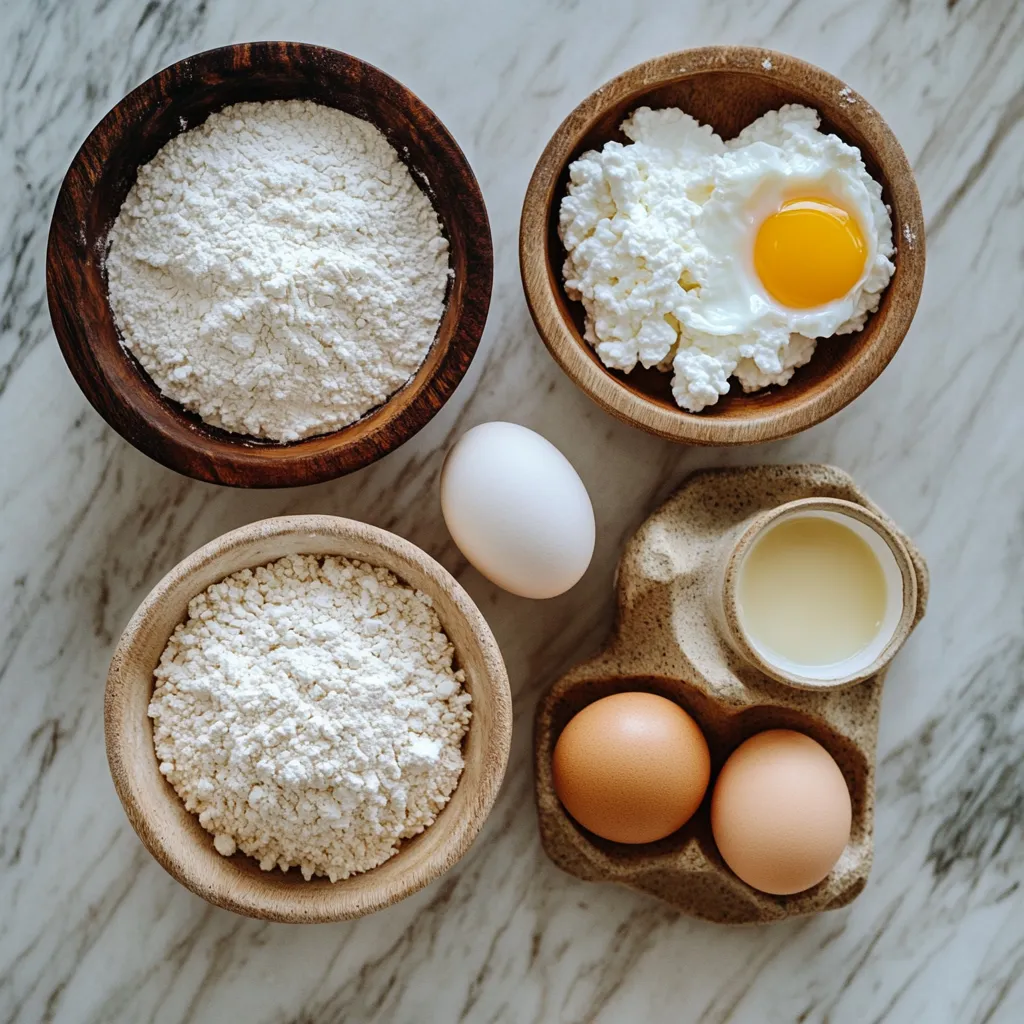Are you tired of high-carb breakfasts that leave you sluggish by mid-morning? If you’re looking for a protein-packed, gluten-free, and low-carb option that still satisfies your cravings for bread, cottage cheese bagels with almond flour might just be your new favorite. This creative twist on traditional bagels combines creamy cottage cheese with the nutty texture of almond flour, creating a chewy, satisfying bake that fits into keto, gluten-free, and health-conscious diets alike.
In this article, you’ll learn everything you need to know about making the perfect almond flour and cottage cheese bagels. From understanding the nutritional value and baking techniques to tips for flavor variations and common mistakes to avoid, we’re covering it all. If you’ve ever wondered how to keep your low-carb baking moist, fluffy, and delicious, you’re in the right place.

Looking for inspiration? Try this 3-ingredient mounjaro recipe you’ll actually crave to pair with your bagels.
What Are Cottage Cheese Bagels with Almond Flour?
What Makes Them Different from Traditional Bagels
Cottage cheese bagels made with almond flour are a far cry from your average bakery bagel. Traditional bagels are made with all-purpose flour and yeast, which results in a dense, chewy texture and high carb content. In contrast, almond flour creates a lighter, slightly nutty flavor while keeping the carb count extremely low. Cottage cheese adds moisture and protein, helping to bind the dough and deliver a satisfying bite without the need for gluten.
Unlike typical bagels, this recipe skips the rising and boiling steps. It’s a one-bowl, mix-and-bake solution that fits easily into your morning routine. That makes them a favorite for busy people who still want a nourishing breakfast.
Most importantly, these bagels are gluten-free, grain-free, and keto-friendly. They’re designed to fuel your body with clean ingredients, not refined flours or added sugars. You get energy, satiety, and flavor all in one.
The Nutritional Profile of Almond Flour and Cottage Cheese
Let’s talk macros. Almond flour is naturally high in healthy fats and low in carbs, making it ideal for anyone on a ketogenic or low-carb diet. It’s also a great source of vitamin E, magnesium, and plant-based protein. Compared to white flour, almond flour has fewer empty calories and a significantly lower glycemic index.
Cottage cheese brings its own nutritional benefits to the mix. It’s rich in casein protein, which digests slowly and keeps you full longer. It also provides calcium, B vitamins, and minimal lactose, making it easier to tolerate than other dairy products.
Here’s a quick comparison:
| Ingredient | Calories (per ¼ cup) | Carbs | Protein | Fat |
|---|---|---|---|---|
| Almond Flour | 160 | 3g | 6g | 14g |
| Cottage Cheese | 80 | 2g | 10g | 1g |
| White Flour | 114 | 24g | 3g | 0g |
As you can see, almond flour and cottage cheese deliver a powerful punch of nutrients without the spike in carbs. This combo creates a more balanced, satisfying breakfast option compared to your average store-bought bagel.
Cottage cheese bagels with almond flour aren’t just another health trend. They’re part of a smarter approach to eating, especially when made at home with clean ingredients.
Looking for inspiration? Try this nutrient-rich idea at Discover great ideas like this 3-ingredient Mounjaro recipe.
Table of Contents
Why Use Almond Flour in Cottage Cheese Bagels?
Almond Flour vs. Traditional Flour: A Keto Perspective
When it comes to making cottage cheese bagels with almond flour, the flour you choose plays a major role in the final result. Traditional all-purpose or bread flour contains a high amount of carbohydrates, which can spike blood sugar levels and kick you out of ketosis. On the other hand, almond flour is naturally low in carbs and packed with healthy fats, making it the go-to option for anyone living a keto or low-carb lifestyle.
For example, one cup of regular flour contains about 95 grams of carbs. Compare that to almond flour, which has just 24 grams of carbs per cup. That’s a huge difference. By using almond flour in your cottage cheese bagels, you’re slashing carb intake without sacrificing flavor or texture.
Almond flour also supports a more stable energy release. Unlike refined flour, it won’t cause a sugar crash an hour after breakfast. That’s why cottage cheese bagels with almond flour are ideal for people who want to feel full and focused throughout the day.
If you’ve ever tried using coconut flour, you know it absorbs a lot of moisture and can create a dense, dry result. Almond flour is more forgiving and creates a softer texture that blends beautifully with cottage cheese. This combination gives the bagels structure, richness, and a mild, nutty flavor that complements both sweet and savory toppings.
Print
Cottage Cheese Bagels with Almond Flour That Make Every Morning Better
- Total Time: 30 minutes
- Yield: 6 bagels 1x
Description
These cottage cheese bagels with almond flour are soft, low-carb, high in protein, and perfect for a keto or gluten-free breakfast. Quick to prepare and full of flavor.
Ingredients
1 cup almond flour
1 cup full-fat cottage cheese
1 large egg
1 teaspoon baking powder
1/2 teaspoon salt
Optional toppings: everything bagel seasoning, sesame seeds, garlic flakes
Instructions
1. Preheat oven to 375°F (190°C) and line a baking sheet with parchment paper.
2. In a bowl, mix almond flour, baking powder, and salt.
3. Stir in cottage cheese and egg until a dough forms.
4. Divide dough into 6 parts and shape each into a bagel.
5. Add optional toppings and place on baking sheet.
6. Bake for 18-22 minutes until golden and firm.
7. Let cool for 5-10 minutes before serving.
Notes
Use full-fat cottage cheese for best texture and moisture.
Store bagels in the fridge for up to 5 days or freeze for longer storage.
Toast before serving for best flavor and texture.
- Prep Time: 10 minutes
- Cook Time: 20 minutes
- Category: Breakfast
- Method: Baking
- Cuisine: Keto
Nutrition
- Serving Size: 1 bagel
- Calories: 220
- Sugar: 1g
- Sodium: 320mg
- Fat: 18g
- Saturated Fat: 5g
- Unsaturated Fat: 12g
- Trans Fat: 0g
- Carbohydrates: 6g
- Fiber: 2g
- Protein: 14g
- Cholesterol: 55mg
Looking for more keto alternatives? Don’t miss our tips in Check out this Himalayan salt keto recipe.
Health Benefits of Almond Flour in Low-Carb Baking
Almond flour isn’t just a low-carb substitute. It’s a nutrient-dense ingredient that brings serious health benefits to your homemade bagels. When used in recipes like cottage cheese bagels with almond flour, it provides a solid foundation of nutrition.
Here are a few key benefits:
1. Rich in Heart-Healthy Fats
Almond flour contains monounsaturated fats, which are known to help lower bad cholesterol and support heart health. These fats also enhance satiety, meaning you feel fuller longer after eating.
2. Packed with Vitamin E
Vitamin E is a powerful antioxidant that supports skin health, immune function, and cellular protection. Cottage cheese bagels with almond flour are a delicious way to sneak more vitamin E into your diet.
3. Naturally Gluten-Free
Because almond flour is made from ground almonds, it contains no gluten. This makes it an excellent choice for people with celiac disease, gluten sensitivity, or anyone avoiding wheat-based products.
4. Low Glycemic Index
Almond flour doesn’t spike blood sugar like white flour does. This makes it ideal for diabetics, those managing insulin resistance, or anyone trying to control sugar cravings.
5. Protein-Rich and Filling
With about 6 grams of protein per 1/4 cup, almond flour enhances the already protein-rich profile of cottage cheese bagels. Together, they create a complete, satisfying breakfast that fuels your body without weighing it down.
By using almond flour in your cottage cheese bagels, you’re turning a simple baked good into a nutrient powerhouse. It’s a choice that supports long-term health, weight management, and dietary goals.
Want to try a similar high-protein, low-carb recipe? Don’t miss our Learn more about this powerful Mounjaro drink.
How to Make Cottage Cheese Bagels with Almond Flour
Simple Ingredients You’ll Need
Making cottage cheese bagels with almond flour is surprisingly easy. You don’t need any fancy equipment or complicated steps. The beauty of this recipe is in its simplicity. It’s a one-bowl mix that bakes quickly and stores well. Before we dive into the steps, here’s what you’ll need to get started.
Basic Ingredients:
- 1 cup almond flour
- 1 cup cottage cheese (full-fat for best texture)
- 1 large egg
- 1 tsp baking powder
- ½ tsp salt
- Optional toppings: everything bagel seasoning, sesame seeds, garlic flakes
If you’re on a keto diet, make sure to use a cottage cheese brand with low carbs and no added sugars. Choose blanched almond flour instead of almond meal for a finer, smoother texture. The difference really shows in the finished product.
Some variations also include mozzarella or a bit of xanthan gum for structure, but the core recipe sticks to clean, basic ingredients. Cottage cheese and almond flour form the base, and the egg acts as a binder.
These ingredients are pantry staples for most low-carb kitchens. If you’re missing anything, it’s worth grabbing them. Once you make these once, they’ll become a regular part of your routine.

Looking for inspiration on low-carb ingredients? Don’t miss our popular Check out the Brazilian Mounjaro tonic.
Step-by-Step Baking Instructions
Step 1: Preheat and Prep
Start by preheating your oven to 375°F (190°C). Line a baking sheet with parchment paper. Lightly spray with oil to prevent sticking.
Step 2: Mix the Dough
In a large bowl, combine almond flour, baking powder, and salt. Stir in the cottage cheese and egg. Mix well until a soft, sticky dough forms. You can use a spatula or your hands. If the mixture feels too wet, let it sit for a minute. Almond flour will absorb moisture as it rests.
Step 3: Shape the Bagels
Divide the dough into four or six equal parts, depending on your preferred size. Roll each portion into a ball, then use your finger to poke a hole in the center and shape it into a classic bagel form.
Step 4: Add Toppings
If you’re adding seasonings like everything bagel mix or sesame seeds, sprinkle them over the top now. Gently press them in so they stick during baking.
Step 5: Bake to Perfection
Place your bagels on the prepared baking sheet. Bake for 18 to 22 minutes, or until golden brown and firm to the touch. Let them cool for 5 to 10 minutes before slicing.
And that’s it. In less than 30 minutes, you’ll have warm, protein-packed cottage cheese bagels with almond flour that are ready to eat, freeze, or take on the go.
These bagels are so easy and versatile that they make meal prep feel effortless. Serve them with cream cheese, avocado, smoked salmon, or almond butter, depending on your mood and macros.
Don’t miss our tips for ingredient swaps in Discover great ideas like this salt trick recipe.
Secrets to Perfecting the Texture and Flavor
How to Keep Bagels Moist Without Gluten
One of the biggest challenges when baking cottage cheese bagels with almond flour is achieving the right texture. Since almond flour is gluten-free, you don’t get the same elasticity and chewiness that comes from traditional flour. But that doesn’t mean you have to settle for dry or crumbly results. With a few tricks, you can make moist, flavorful bagels that feel like the real thing.
The key lies in balance. Cottage cheese adds moisture and helps bind the ingredients, but it’s important to use the right ratio. If your mixture is too wet, the bagels may spread too much. Too dry and they’ll fall apart. Start with one cup of cottage cheese to one cup of almond flour and adjust slightly if needed.
Make sure to use full-fat cottage cheese. The extra fat adds richness and keeps your bagels soft on the inside while crisping up the outside during baking. Letting the dough rest for a few minutes before shaping also helps. Almond flour will absorb some of the moisture, creating a better texture.
Another important tip is baking time. Overbaking can make your cottage cheese bagels with almond flour turn dry and tough. Check them around the 18-minute mark. Once the tops are golden and slightly firm to the touch, they’re done.
If you’re looking for more moisture, try adding a tablespoon of plain Greek yogurt to the dough. It enhances the softness without overpowering the almond flavor.

Looking for more moist keto baking ideas? Learn more about how to enhance texture with healthy fats in Learn more about this Brazilian Manjero drink.
Tips for Balancing Cottage Cheese and Almond Flour
Flavor is just as important as texture, especially when you’re creating a recipe that skips the usual flour and yeast. Cottage cheese bagels with almond flour already bring a creamy, nutty taste. The goal is to enhance that flavor without overpowering it.
One way to boost flavor is by seasoning your dough. Try adding a pinch of garlic powder, onion powder, or even dried herbs like rosemary or thyme. For sweet versions, a little cinnamon and stevia go a long way. These small additions make a big impact.
When it comes to salt, don’t be shy. A little salt in the dough plus a sprinkle on top brings out the richness of both cottage cheese and almond flour. It also helps balance the naturally sweet undertones of almond flour.
Another smart move is brushing the tops with egg wash before baking. This gives the bagels a beautiful golden crust and adds a subtle crispness that contrasts with the soft interior.
If you’re planning to store your cottage cheese bagels with almond flour for later, toast them before serving. Toasting brings out the almond flavor and revives the fresh-baked taste.
Perfecting the flavor of almond flour-based bagels is a process, but once you get it right, you’ll never go back to store-bought. These bagels can be tailored to match your taste preferences, whether you like savory breakfast sandwiches or light, sweet snacks.
Variations and Add-Ons for Extra Flavor
Sweet and Savory Mix-Ins
One of the best things about cottage cheese bagels with almond flour is how customizable they are. The base recipe is mild and neutral, making it the perfect canvas for both sweet and savory creations. Whether you’re craving something hearty or something with a hint of sweetness, you can tweak your cottage cheese bagels with almond flour to match your taste.
For a savory twist, consider adding shredded cheddar, garlic powder, or dried chives into the dough. These ingredients blend beautifully with the creamy cottage cheese and nutty almond flour. You can also stir in everything bagel seasoning for extra crunch and flavor in every bite.
If you want your cottage cheese bagels with almond flour to lean sweet, try folding in cinnamon and a touch of vanilla extract. You can even add sugar-free chocolate chips or blueberries. These additions give your bagels the feel of a pastry without the carb overload.
The secret is keeping balance. Almond flour has a slightly sweet undertone already, and cottage cheese is mild and creamy. So a little goes a long way. By choosing your mix-ins wisely, you can transform a simple recipe into a bakery-style treat made right at home.
Looking for other fun variations? Don’t miss our Discover great ideas like this 4-ingredient Mounjaro recipe.
Toppings That Work with Almond Flour Bagels
When you pull your cottage cheese bagels with almond flour out of the oven, the fun doesn’t stop. Toppings can take your low-carb bagels to the next level, adding texture, flavor, and even extra nutrients.
Some classic savory toppings include:
- Everything bagel seasoning
- Sea salt and crushed garlic
- Shredded parmesan or asiago cheese
- Sesame or poppy seeds
For sweet versions of cottage cheese bagels with almond flour, consider topping them with:
- Ground cinnamon and erythritol
- Slivered almonds or crushed walnuts
- Coconut flakes
- A drizzle of sugar-free honey substitute
To apply toppings, brush the unbaked bagels with an egg wash and sprinkle your toppings generously. The egg helps everything stick and adds a golden finish once baked.
You can also layer on toppings after baking. Try cream cheese, mashed avocado, smoked salmon, or almond butter. These options not only taste great, they also add protein and healthy fats to your meal. It’s a delicious way to build a breakfast or snack that keeps you full for hours.

Cottage cheese bagels with almond flour aren’t just a healthy alternative. They’re a flexible, flavorful option that fits into many eating styles. Whether you want something savory for brunch or something sweet for a post-workout bite, you can make it work with a few creative tweaks.
Keto and Gluten-Free Adaptations
Making the Recipe 100 Percent Keto-Friendly
Cottage cheese bagels with almond flour are already low in carbs, but with a few careful adjustments, you can make them even more keto-focused. These bagels naturally fit the keto lifestyle because almond flour is rich in healthy fats and low in net carbs, and cottage cheese provides a solid protein base without the sugar spikes caused by traditional dairy.
To make sure your cottage cheese bagels with almond flour stay within keto macros, choose full-fat dairy products. Avoid low-fat or fat-free cottage cheese since they often include fillers or added sugars that can increase carb count. Stick with clean, full-fat versions that contain only milk, cream, and salt.
Double-check your baking powder too. Some brands use cornstarch or hidden carbs. Opt for aluminum-free baking powder without additives. You can also make your own by combining cream of tartar and baking soda if you want total control over ingredients.
Consider adding keto superfoods like flaxseed meal or chia seeds into the dough. These will improve texture, add fiber, and keep your blood sugar levels stable. Plus, they boost the nutritional value of your cottage cheese bagels with almond flour while helping you feel full longer.
If you’re extremely carb-conscious, you can reduce the amount of almond flour slightly and replace a small portion with protein powder. This swap cuts the carbs even more while increasing protein, which is especially helpful for those on strict ketogenic macros.
Cottage cheese bagels with almond flour are an excellent fit for clean keto, dirty keto, and even lazy keto approaches. They’re satisfying, customizable, and easy to track within a meal plan.
Gluten-Free Tips for Bagel Success
Since almond flour is naturally gluten-free, it’s the perfect base for gluten-free bagels. But baking without gluten can come with challenges. Cottage cheese bagels with almond flour don’t rely on gluten to rise or bind, so you’ll need to pay attention to texture and technique.
To help your gluten-free bagels hold together, mix the dough well but avoid overworking it. Letting the dough rest for 5 to 10 minutes allows almond flour to absorb moisture, creating a firmer shape that won’t collapse in the oven.
Use parchment paper or a silicone baking mat to prevent sticking, since almond flour is delicate and can break apart if not handled gently. When shaping your cottage cheese bagels with almond flour, wet your hands slightly. This keeps the dough from sticking and allows you to mold smooth, round bagels easily.
If you’re new to gluten-free baking, avoid using almond meal, which contains the almond skins and has a rough texture. Instead, use finely ground blanched almond flour for the best results. This ensures your cottage cheese bagels with almond flour come out soft, uniform, and bakery-quality.
Storage also matters in gluten-free baking. Because these bagels don’t contain preservatives or gluten, they’re best kept in the fridge in an airtight container. You can reheat them in a toaster or oven to restore their texture without drying them out.
With the right ingredients and preparation, you can enjoy cottage cheese bagels with almond flour that are completely gluten-free and still taste amazing. They’re perfect for people with celiac disease or anyone looking to avoid processed wheat.
Common Mistakes and How to Avoid Them
Why Almond Flour Bagels Turn Out Too Crumbly
One of the most common issues people face when baking cottage cheese bagels with almond flour is getting a crumbly texture. If your bagels are falling apart, it usually comes down to the wrong flour-to-moisture ratio or skipping essential binding ingredients.
Almond flour does not contain gluten, so it lacks the natural elasticity that helps hold baked goods together. That’s why cottage cheese and egg are critical in this recipe. They both act as binders. If you use too little egg or reduce the cottage cheese, the dough will become dry and won’t hold its shape.
Another common mistake is overbaking. Cottage cheese bagels with almond flour bake quickly. Leaving them in the oven too long will dry out the moisture and lead to crumbly or hard bagels. Always check for doneness by lightly pressing the top. When it feels firm and slightly golden, it’s time to remove them from the oven.
Using the wrong kind of almond flour also makes a difference. Coarse almond meal can cause your bagels to break apart. For best results, always use blanched, finely ground almond flour. This gives the dough a soft, even consistency that mimics traditional flour without the carbs.
If your bagels are still crumbling, consider adding a tablespoon of flaxseed meal or psyllium husk to the dough. These ingredients help absorb moisture and provide structure, especially in gluten-free recipes like cottage cheese bagels with almond flour.
Cottage Cheese Consistency: What to Know Before Baking
Not all cottage cheese is created equal. The texture and water content in your cottage cheese can make or break your bagel dough. When making cottage cheese bagels with almond flour, aim for thick, full-fat cottage cheese. Avoid brands that are overly watery or labeled as “low-fat” or “diet.” These versions often have added ingredients and less binding power.
If your cottage cheese has too much liquid, your dough will be too wet and difficult to shape. To fix this, you can strain the cottage cheese through a fine mesh sieve or cheesecloth to remove excess moisture. It only takes a few minutes and results in a richer, more stable dough.
Also, avoid using whipped or blended cottage cheese. These textures don’t provide the same structure and may make the dough too loose. The classic small curd cottage cheese works best when making cottage cheese bagels with almond flour. It creates little pockets of moisture and protein that enhance both flavor and texture.
Temperature matters too. Using cottage cheese straight from the fridge can cause uneven mixing. Let it sit at room temperature for 10 to 15 minutes before combining it with the almond flour. This simple step helps the ingredients blend more smoothly and creates a more consistent dough.
Paying attention to your cottage cheese is just as important as choosing high-quality almond flour. When both ingredients are in balance, your cottage cheese bagels with almond flour will turn out perfectly every time.
Storage, Meal Prep, and Freezing Tips
How to Store Your Bagels for Freshness
Cottage cheese bagels with almond flour are best enjoyed fresh out of the oven, but with the right storage techniques, you can keep them moist and delicious for several days. These bagels are naturally low in preservatives, so proper storage is essential to maintain their texture and flavor.
Once your cottage cheese bagels with almond flour have cooled completely, place them in an airtight container. Store them in the refrigerator to keep them fresh for up to five days. Because they contain cottage cheese, it’s best not to leave them at room temperature for long periods.
To preserve the texture, line the bottom of the container with a paper towel. This helps absorb any excess moisture and prevents the bagels from becoming soggy. If stacking the bagels, place another sheet of paper towel between layers.
When you’re ready to eat, reheat your bagels in the toaster or a preheated oven at 350°F for 5 to 7 minutes. This helps restore the crisp outside and soft, chewy center that makes cottage cheese bagels with almond flour so satisfying.

Avoid microwaving, which can make the bagels rubbery or dry. Reheating in the oven or toaster provides the best results, especially if you plan to serve them as part of a breakfast sandwich or with toppings.
Freezing Techniques for Almond Flour Bakes
If you want to make a large batch of cottage cheese bagels with almond flour ahead of time, freezing is a smart option. These bagels freeze well and can be stored for up to two months without losing their quality.
Start by letting your bagels cool completely after baking. Then, wrap each bagel individually in plastic wrap or parchment paper. This prevents freezer burn and helps lock in moisture. After wrapping, place the bagels in a zip-top freezer bag or airtight container.
Label the bag with the date so you can track how long they’ve been stored. When you’re ready to eat one, simply take it out of the freezer and thaw it at room temperature for about 30 minutes. Then reheat in the oven or toaster for a fresh, warm finish.
For an even faster option, slice your cottage cheese bagels with almond flour before freezing. This way, you can pop the frozen halves directly into the toaster without waiting for them to thaw. It’s a time-saving tip that makes meal prep seamless.
Freezing your cottage cheese bagels with almond flour ensures you always have a healthy, homemade option on hand. Whether you’re prepping breakfast for the week or planning ahead for busy mornings, frozen bagels are a perfect solution that fits into any schedule.
How These Bagels Fit Into a Healthy Diet
Perfect for Keto, Low-Carb, or Gluten-Free Lifestyles
Cottage cheese bagels with almond flour are more than just a tasty breakfast. They’re a smart choice for anyone trying to maintain a clean, healthy eating pattern. Whether you’re following a ketogenic diet, going gluten-free, or just cutting back on refined carbs, these bagels make it easy to stick to your goals without feeling deprived.
Unlike traditional bagels made with white flour, which can contain over 50 grams of carbs per serving, cottage cheese bagels with almond flour keep your carb count low while delivering a satisfying texture and rich flavor. The healthy fats in almond flour and the protein in cottage cheese work together to keep you full, support energy levels, and reduce cravings.
If you’re on a low-carb or keto plan, you already know how hard it can be to find satisfying bread alternatives. These homemade bagels fit right into your lifestyle. They’re naturally grain-free, sugar-free, and free of unnecessary fillers. That means no empty calories and no blood sugar spikes.
People with gluten sensitivity or celiac disease can enjoy these bagels too. Since almond flour contains no wheat, there’s no risk of gluten contamination when you use clean ingredients and a gluten-free kitchen setup.
Adding cottage cheese bagels with almond flour to your weekly meal plan helps you stay consistent with your nutritional goals while enjoying comfort foods in a healthier form. They’re ideal for breakfast, brunch, or an afternoon snack that won’t throw off your macros.
Comparison with Store-Bought Bagels and Macros Table
To understand the full nutritional advantage of cottage cheese bagels with almond flour, it’s helpful to compare them to traditional store-bought bagels. Let’s take a closer look at how they measure up in calories, carbs, protein, and fat.
| Bagel Type | Calories | Net Carbs | Protein | Fat |
|---|---|---|---|---|
| Traditional Plain Bagel (100g) | 270 | 50g | 9g | 1.5g |
| Cottage Cheese Bagel with Almond Flour (homemade, 100g) | 220 | 6g | 14g | 18g |
As you can see, cottage cheese bagels with almond flour offer significantly fewer carbs and more protein and fat. This balance helps regulate hunger hormones and supports better metabolism throughout the day.
Store-bought bagels are also often packed with preservatives, bleached flours, and added sugars. In contrast, cottage cheese bagels with almond flour are clean, simple, and made from real ingredients. They allow you to take control of what you eat without compromising taste or satisfaction.
By choosing these homemade bagels, you’re skipping the carb crash and choosing a nutrient-rich option that actually supports your health goals. With every bite, you fuel your body in a way that aligns with mindful eating.
Conclusion
Cottage cheese bagels with almond flour are more than just a trending recipe. They are a smart, nutritious, and delicious alternative to traditional bagels that often come loaded with carbs and refined ingredients. Whether you’re living a keto lifestyle, managing gluten intolerance, or simply looking for healthier breakfast choices, these homemade bagels deliver all the flavor and satisfaction without the guilt.
With just a few simple ingredients like almond flour, cottage cheese, and eggs, you can bake fresh, protein-packed bagels in under 30 minutes. The combination of almond flour and cottage cheese gives you a perfect balance of healthy fats, low carbs, and satisfying texture. These bagels are ideal for meal prep, freezer-friendly, and endlessly customizable with both sweet and savory add-ins.
What truly sets cottage cheese bagels with almond flour apart is their versatility. You can enjoy them with cream cheese, eggs, avocado, or even sugar-free jam. You can make them plain, cheesy, spicy, or sweet. No matter how you flavor them, they support your health goals and keep your energy stable throughout the day.
Instead of buying overly processed, high-carb bagels at the store, you can make your own cottage cheese bagels with almond flour in your kitchen using clean, whole ingredients. The taste is better. The nutrition is better. And the control is fully in your hands.
Looking for more clean, low-carb recipes that support your wellness journey? Don’t miss our Learn more about this natural pink salt morning habit to start your day right.
for more follow us on facebook and pinterest
Frequently Asked Questions
Can you use almond flour for cottage cheese bagels?
Yes, almond flour is actually one of the best ingredients to use when making cottage cheese bagels. Almond flour is low in carbs, gluten-free, and full of healthy fats. It combines perfectly with cottage cheese to create a soft, moist dough that bakes into fluffy, flavorful bagels. Cottage cheese bagels with almond flour are ideal for anyone following a low-carb, keto, or gluten-free lifestyle. The almond flour not only replaces traditional wheat flour, it also adds a slightly nutty flavor and boosts the nutritional value of your bagels.
What is the secret to baking with almond flour?
The secret to baking with almond flour is moisture balance and choosing the right type of flour. Use finely ground blanched almond flour for smooth texture and better structure. Because almond flour doesn’t absorb liquid like traditional flour, it’s important to use binding ingredients like eggs and cottage cheese. In cottage cheese bagels with almond flour, the cottage cheese adds moisture and protein, while the almond flour provides fat and structure. Letting the dough rest helps almond flour absorb moisture more evenly, and baking at a moderate temperature helps keep the bagels soft and tender.
What is the best flour for bagels?
It depends on your health goals. For traditional chewy bagels, high-gluten bread flour is often preferred. But if you’re looking for a healthier option, almond flour is an excellent choice. Almond flour is perfect for gluten-free and low-carb diets. When combined with cottage cheese, it creates a dough that is soft, rich in protein, and easy to work with. Cottage cheese bagels with almond flour offer the best of both worlds: the comfort of a bagel and the benefits of a high-protein, low-carb recipe. So if you’re avoiding gluten or cutting carbs, almond flour is the best flour for your bagels.
What are the ingredients in the 3 ingredient keto bagel with almond flour?
The basic 3 ingredient keto bagel includes almond flour, cottage cheese, and eggs. These three ingredients are all you need to make a simple and delicious low-carb bagel. Almond flour gives the bagel its structure, cottage cheese adds moisture and protein, and the egg binds everything together. This minimalist recipe keeps carbs low while still creating a satisfying texture. If you want to get creative, you can add seasonings like garlic powder or everything bagel spice. But even the basic version of cottage cheese bagels with almond flour tastes great on its own and fits perfectly into any keto meal plan.

